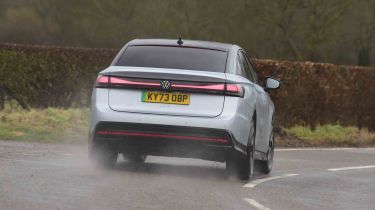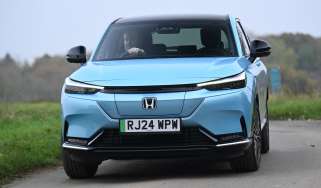Volkswagen ID.7 - Electric motors, performance & drive
The ID.7 prioritises comfort and refinement over outright handling prowess and power

In short, the Volkswagen ID.7 does a good job of hiding its size, but it just lacks the ultimate agility of a BMW i4 or Model 3 point-to-point, tending to lean over more in bends and feeling lazier to respond to quick changes of direction. It also isn’t as quick as its Model 3 rival in standard form, although anyone coming to the ID.7 from a traditional petrol or diesel car is unlikely to be disappointed. Refinement and ride comfort are ID.7 strong points, which go hand in hand with it being a long-distance EV.
|
Model |
Power |
0-62mph |
Top speed |
|
ID.7 Pro Match |
282 bhp |
6.5 seconds |
112 mph |
|
ID.7 Pro S Match |
282 bhp |
6.6 seconds |
112 mph |
|
ID.7 4Motion GTX |
355bhp |
5.5 seconds |
112 mph |
What is the Volkswagen ID.7 like to drive?
In town
At nearly five metres long, the ID.7 isn’t going to be the easiest car to slot into a parking space, but the 360-degree camera system and parking sensors front and rear give you some assistance.
All the controls are smooth, although we would like there to be more adjustment in the regenerative braking system. It works automatically by increasing the regen as you approach junctions, using information from either the navigation system or the camera and radar systems spotting slower-moving traffic ahead. Alternatively, it can be on all the time when you lift off the accelerator if you’ve engaged the ‘B’ mode on the gear selector. The latter isn’t quite strong enough to offer the one-pedal driving mode of cars like the Model 3 or the e-Pedal system used in the Nissan Ariya, though.
Other than that, the ride is commendably supple at low speeds despite the big 19-inch alloy wheels that come as standard, especially when you have the optional adaptive suspension that’s available in conjunction with the Exterior Pack Plus. This allows you to soften the suspension to deal with the harshest shocks from potholes and speed bumps.
On A- and B-roads
We also found the optional adaptive suspension provides excellent damping at higher speeds. Even when paired with the largest 20-inch wheels and the suspension in its firmest setting, the ID.7 still manages to deal with bigger bumps well and feels resolutely tied down at all times, if a touch fidgety over rougher road surfaces. In its softest setting, that slight fidget disappears, and the ID.7 feels positively serene, floating over uneven surfaces that rivals like the Hyundai Ioniq 6 and Polestar 2 would jiggle over. As you’d expect, this makes the ID.7 an incredibly refined long-distance cruiser, yet that sense of being isolated from the outside world doesn’t come at the expense of body control, and the ID.7 has an inherently wide track that aids stability.
Even in the pouring rain and in single-motor guise, the ID.7 provides all the traction you need. For those after something even more capable in slippery conditions, a dual-motor GTX model with the added traction of four-wheel drive is also available. This version doesn’t feel any sportier than the standard ID.7, but you can sense the front motor kick in to drag you out of trouble should the back of the car start to slip a little in a tight bend.
There’s no getting around the fact that the ID.7 is a very heavy car, though. All versions weigh over two tonnes, and even putting the car in its firmest driving mode cannot disguise the reality that the ID.7 is a big car clearly set up for comfort rather than driving thrills. It would be good if there were a little more bite to the brake pedal, because it feels a bit soft and doesn’t give you the same confidence when driving quickly as you get from the BMW i4 or Tesla Model 3
On the motorway
The Volkswagen ID.7 is definitely the most grown-up of Volkswagen’s electric-car range – and this feeling continues at higher speeds. Laminated side windows (the optional Exterior Pack Plus adds laminated side glass for the rear passenger doors) make this an almost eerily quiet car at low speeds, but even on the motorway, the ID.7 remains impressively refined, even when fitted with the largest 20-inch wheels.
All versions come with an adaptive cruise control system with lane assist to offer a semi-autonomous driving experience. When switched on, it helps with steering and braking to take some of the strain out of long drives, and manages to keep you centred in your lane, avoiding the sensation that you’re being bounced between the markings.
Engines, 0-60 acceleration and top speed
Even with a not inconsiderable 282bhp on tap in the ID.7, its 2,100kg weight (the four-wheel-drive GTX is 2,253kg) means that performance is some way off the class best. Don’t get us wrong, a 0-62mph time of 6.5 seconds (6.6 seconds for the heavier Pro S version) isn’t anything to be sniffed at, because it compares well with a traditional petrol or diesel car. But you’ll need the costliest GTX version with 335bhp in order to beat the acceleration times of even the entry-level Tesla Model 3 RWD or single-motor Polestar 2.
The 5.4-second 0-62mph sprint of the GTX is still more than swift enough in the real world, but it isn’t going to eclipse the sub-3.0-second 0-62mph time of the cheaper Tesla Model 3 Performance. All versions of ID.7 have a top speed of 112mph, which is more than enough in the UK, and would only be important in countries with an unlimited top speed on their motorways.










